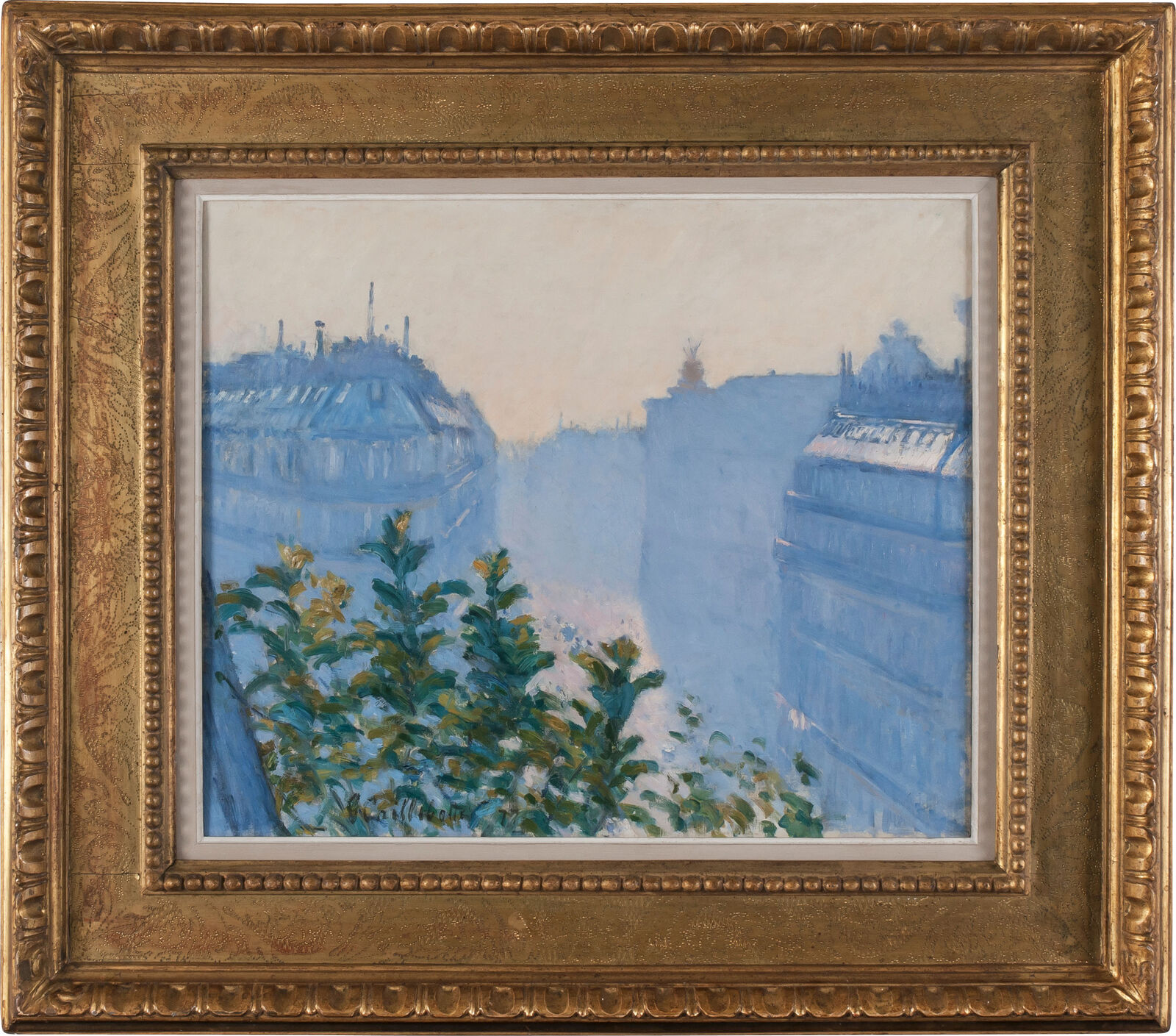Gustave Caillebotte
Rue Halévy, View from a Balcony, 1877
On view
7 further works by Caillebotte
Copy link
Oil on canvas, 54 x 65,5 cm
Signed and dated lower left: G. Caillebotte 77
Inv.-no. MB-Cai-01
Gustave Caillebotte featured the impressive apartment buildings around the Paris Opera in three paintings. From this perspective, the balcony plants block the view, compelling the beholder to look more closely. The cold, hazy morning light is combined with the silver-gray of the zinc roofs to produce a symphony in shades of blue-violet.
During the so-called Second Empire (1852–70), the reign of Napoleon III, the city of Paris underwent profound changes. Under the direction of Baron Georges-Eugène Haussmann, prefect of the Seine, the core of the old city with its narrow medieval streets was replaced by a network of wide boulevards and avenues. The lavish construction of numerous city squares, gardens, and parks brought air and light into the metropolis. Everywhere, this newfound spaciousness offered room for leisure activities and recreation. Countless bars, cafés, theaters, and department stores endowed the modernized capital city with an opulence that was likewise expressed in the unified streetscapes and painstakingly restored historical monuments. By 1870 Paris was considered the most advanced metropolis in the world and the unrivalled center of modern painting.
Like many of his colleagues, Gustave Caillebotte was fascinated by the results of “Haussmannization” and documented it in numerous compositions. At the invitation of his painter friends Henri Rouart and Pierre-Auguste Renoir, he had participated in the second Impressionist exhibition of 1876, thereby joining the movement that had grown up around Claude Monet in the early 1860s. A year later, he attracted public attention with his important large-scale painting Paris Street; Rainy Day (1877, The Art Institute of Chicago)—a monumental, seemingly photorealistic view of the new Paris in which the artist adopted the vantage point of a passerby on the street. The painting Rue Halévy, View from a Balcony, created the same year, belongs to a series of works in which the city center of Paris is viewed from a dramatic height. For this composition, Caillebotte positioned his easel on the top story of a building on the Rue La Fayette. The opera house built by Charles Garnier appears in the distance, identified by the golden sculptures in the upper half of the picture. In the foreground, the luxuriant green foliage of the balcony plants serves as a repoussoir and contrasts starkly with the violet-colored haze enveloping the grand buildings along the boulevard. The houses in the foreground show Haussmann’s typical design with their symmetrical, cream-colored sandstone façades, while the rest of the buildings merge into near flatness—an effect indicative of the influence of colored Japanese woodcuts. In contrast to Paris Street; Rainy Day, there are no anecdotal details; instead, Caillebotte omitted narrative elements in favor of an atmospheric image reminiscent of a stage set. Even after joining the Impressionists in 1876, the artist still frequently painted in an academic manner; here, however, the loose brushwork and abstract approach resemble the work of Monet.
Rue Halévy, View from a Balcony is not listed in the catalogue raisonné of Caillebotte’s paintings compiled by Marie Berhaut. Although it is signed and dated, it may have been a study. The work is directly related to two other city views painted from the same rooms and listed in the catalogue as nos. 99 and 100. The authenticity of this painting has been confirmed by the Comité Caillebotte.
Daniel Zamani
Gustave Caillebotte: The Painter’s Eye, National Gallery of Art, Washington, June 28–October 4, 2015; Kimbell Art Museum, Fort Worth, November 8, 2015–February 14, 2016, no 10
Impressionism: The Hasso Plattner Collection, Museum Barberini, Potsdam, from September 5, 2020
Monet and the Impressionist Cityscape, Alte Nationalgalerie, Berlin, September 27, 2024–January 26, 2025
n.d., Alfred Henri Bramtot
1894, Henri Poterin du Motel
1934, Solange Poterin du Motel, Paris, inherited from the above
1977, Paul Cosnard, Paris
1986, Private collection, Paris, inherited from the above
May 2020, purchased from a private collection
Gustave Caillebotte: The Painter’s Eye, exh. cat. National Gallery of Art, Washington 2015, no. 10, p. 277, ill. p. 146
Impressionism: The Hasso Plattner Collection, exh. cat. Museum Barberini, Potsdam 2020, p. 96/97, 264, ill. p. 98, 264
Video
Do you have suggestions or questions?
sammlung@museum-barberini.de.

